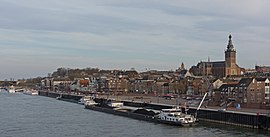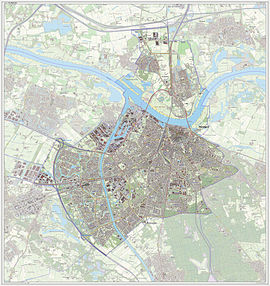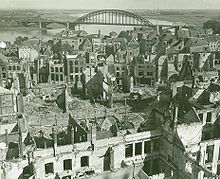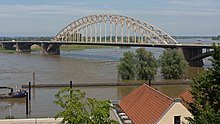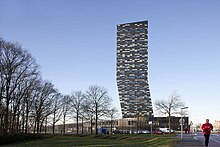Nijmegen
 flag |
 coat of arms |
| province |
|
| mayor | Hubert Bruls ( CDA ) |
| Seat of the municipality | Nijmegen |
|
Area - land - water |
57.6 km 2 53.61 km 2 3.99 km 2 |
| CBS code | 0268 |
| Residents | 176,508 (Jan 31, 2019) |
| Population density | 3064 inhabitants / km 2 |
| Coordinates | 51 ° 50 ′ N , 5 ° 52 ′ E |
| Important traffic route |
|
| prefix | 024, 0481 |
| Postcodes | 6501, 6503-6504, 6511-6512, 6515, 6521-6525, 6531-6538, 6541-6546, 6564, 6574, 6663 |
| Website | Homepage of Nijmegen |
| View of Nijmegen | |
Nijmegen [ ˈnɛiˌmeːɣə (n) ] ( ), German Nijmegen , rarely also Nymwegen , in Nijmegen Nimwèège [ nɪmˈʋɛːʝə ], is a municipality with 176,508 inhabitants (as of January 31, 2019) in the province of Gelderland in the east of the Netherlands , which is in the immediate vicinity of the border with the German region of Lower Rhine . Nijmegen was the most important of the four main towns in the county of Geldern and became a member of the Hanseatic League in 1402 .
Surname
The name Nijmegen goes back to the Latin name Noviomagus , which indicates the city's Roman origins. Noviomagus consists of the Latin word novus (Dutch nieuw , German new ) and magus (Dutch market , German market ), which is probably of Celtic origin. So the name Nijmegen initially stood for a new market . Different spellings such as Novimagus, Novomagus, Neomagus or Noviomagi developed over the centuries . In the time of Charlemagne the place was called Numaga , which changed in the course of history in Nieumeghen or Nimmegen (see also the German Neumagen ). The latter is always recognizable in the German exonym Nijmegen . The name in Nimweg (en) er Platt (Dutch Nijmeegs ) is Nimwèège .
geography
location
Nijmegen is 15 kilometers south of Arnhem near the German municipalities of Kranenburg and Kleve . In the north, the Waal , which emerges from the Rhine near Pannerden as one of the rivers of the Rhine-Maas delta, formed the city limits until the 1990s . Since then, the ninth and thus youngest district with the name Waalsprong (actually Nijmegen-Noord ) has been located there.
Community structure
The municipality of Nijmegen is divided into the following nine districts:
| No. | district | Population (Jan. 1, 2018) |
|---|---|---|
| 01 | Nijmegen Center | 12,055 |
| 02 | Nijmegen-Oost | 34,515 |
| 03 | Nijmegen-Oud-West | 14,920 |
| 04 | Nijmegen-Nieuw-West | 16,790 |
| 05 | Nijmegen-Midden | 18,700 |
| 06 | Nijmegen-Zuid | 23,665 |
| 07 | Dukenburg | 22,025 |
| 08 | Lindenholt | 14,800 |
| 09 | Nijmegen-Noord | 18,475 |
Only since 1998 has the number of boroughs correspond to today's. At that time, housing estates were built north of the Waal for the first time in today's Nijmegen-Noord district, which is why it is also called Waalsprong . The Dukenburg district has existed since 1965 and the first construction work in Lindenholt began in 1977.
Neighboring communities
| Overbetuwe | Lingewaard | |
| Beuningen |

|
Berg en Dal |
| Wijchen | Hay |
history
Antiquity
The Hanseatic city of Nijmegen describes itself as the oldest city in the Netherlands . The history of the city goes back to the time of the Roman Empire ; In 2005 the 2000 year celebration took place, the Romans entertained here since 19 BC. Various military bases and founded a civil settlement, Ulpia Noviomagus Batavorum , in 104 AD . ( Maastricht in the south of the Netherlands also claims to be the oldest city in the country.) The military locations changed: from 19 BC. BC to 12/10 BC The garrison was on the Hunnerberg , from 12/10 BC. BC to AD 69 on the Kops Plateau and again on the Hunnerberg from AD 69 to the middle of the second century. From the end of the fourth century to the beginning of the fifth century there was another late antique fortification in the area of the later Palatinate Hill. After the Romans withdrew around 410, their administrative and military functions were also lost. Numerous excavation finds in the city area show a late antique-early medieval settlement continuity from the fourth to the seventh century.
middle Ages
The Roman fortifications went to the Merovingian kings and then to the Carolingian kings. There is evidence of a Merovingian mint at the beginning of the 7th century. The Palatinate Church from the first quarter of the 7th century also served as a parish church . Nijmegen was a castrum against the neighboring peoples of Saxony and Frisians . Charlemagne built a palace on the walls of the fort in 777 , but this was only completed after his death. The associated village was referred to as a villa . Ludwig the Pious often stayed in the Palatinate. The Palatinate was the center of an extensive royal estate district (fiscus Niumaga) with imperial forest. Around the year 880 the Normans took the Palatinate, which they burned down when they later withdrew.
Nijmegen was established as a trading post probably before the year 1000 between today's Grotestraat, Priemstraat and Nonnenstraat, west of the Palatinate Hill in the immediate vicinity of the Waal. During the Ottonian and Salic times, royal or imperial court days took place in the place. The St. Nicholas Chapel , one of the few remaining Romanesque central buildings , was built in the Palatinate around 1030 . It was a central building based on the model of the Carolingian Palatinate Church in Aachen.
Frederick Barbarossa , Emperor of the Holy Roman Empire was in the year 1047 by Duke Godfrey the Bearded burned Palatinate in 1155 in a sprawling castle complex , the Valkhof rebuild. However, only two of these chapels have survived in the 21st century. Nijmegen had a royal mint since the end of the 12th century, and a count since 1247. An extensive judicial district in the surrounding area was connected to the burgraviate , which included Ubbergen and Groesbeck .
Under Henry VII , Nijmegen became a free imperial city in 1230 . Shortly afterwards, on October 8, 1247, the imperial city came into the hands of Gelderland . Count Otto II of Gelderland received the city as a pledge from the Roman-German King Wilhelm II (who was also Count of Holland). Because the fief could not be released, it remained in the possession of the Lords of Geldern from then on. Under Otto II, the construction of the Stevenskerk began in 1250 , a church that still dominates the silhouette of Nijmegen today. Around 1300 the city wall was built (area 29 ha).

Despite the Great Plague in 1345, the population of Nijmegen increased continuously. Nijmegen became a member of the Hanseatic League in 1402. Trade relations were established with England and the Baltic Sea.
Between the 15th and 19th centuries
In the middle of the 15th century, the city is said to have had over 10,000 inhabitants. The construction and renovation of numerous churches and monasteries attracted craftsmen and artists to the city. During this time, the Nijmegen crane ( Nijmegse Craen (Kraan) , a stone house or step-wheel crane as a harbor crane ) was built on the Waalkade to support trade . It also served as a guard house and was demolished in 1882 due to its dilapidation. The Reformation was initially well received.
Nijmegen became the most important of four main towns in the Duchy of Geldern . In 1543 Nijmegen came into Spanish possession with the rest of the Geldernland through the Treaty of Venlo . Prince Moritz conquered the city in 1591. At Nijmegen, the Peace of Nijmegen was signed in 1678 between France and the Republic of the Seven United Netherlands . Under Napoleon, Nijmegen came under French rule until it finally became part of the Kingdom of the Netherlands in the Congress of Vienna in 1815 .
From the 20th century
In 1923 a Catholic university opened in Nijmegen ( Katholieke Universiteit Nijmegen , or KUN for short).
On February 22, 1944, during World War II , an Allied bombardment had severely destroyed the city: after a mission to Gotha (where a Messerschmitt AG plant was located ), the bomber crews flying back probably succumbed to it in search of a secondary target It was a mistake to fly to German Kleve . Almost 800 people died, including all people in a school building. In September 1944, Nijmegen suffered further war damage during the Battle of Arnhem . In February 1945, the so-called Battle of the Reichswald took place in nearby Klever Reichswald and in the vicinity of today's city . After this battle the Allies were able to build a bridgehead over the Rhine near Wesel and from there take the Ruhr area.
The university, which opened on October 17, 1923, was renamed Radboud Universiteit Nijmegen (RU for short) in 2004 in order to form a unit by name with the nationally known University Hospital Radboudumc .
The city administration commemorated the bomb victims from the ZWK with the design of information boards on the sidewalks of the city center. These round stainless steel plaques are marked on the outside as Brandgren's Bombardment 1944-02-22 and mark earlier building locations or name people who perished on the exact spot.
Transport and economy
Rail-bound transport
Railways and motorways connect the city with Arnhem, 's-Hertogenbosch and Venlo . The Nijmegen train station is on the railway line Arnhem-Nijmegen since 1879 from the north, on the Nijmegen Tilburg railway since 1881 from the west and on the Maas line achieved since 1883 from the south; the historically oldest connection on the left Lower Rhine route (1865–1991) from the east is now idle. The station building, however, was also a victim of the bombing in 1944. In 1955, today's station (see picture) was completed.
Nijmegen owned a tram until 1955 . The introduction of a regional light rail system is under discussion (as of 2018).
Local public transport and car use
The city buses of the transport company Hermes run under the name Breng . Nijmegen is also served by regional buses.
Nijmegen is on the European route 31 to Papendrecht (South Holland), to Goch (Left Lower Rhine), Cologne and Hockenheim (Rhein-Neckar-Kreis).
Cyclists
Since May 19, 2016, Nijmegen has been considered the best Dutch bicycle city for two years (Fietsstad 2016) . In 2017, together with Arnhem , she hosted the Velo City international bicycle conference . The city is connected to the Via Romana long-distance cycle route, which runs from Xanten to here.
Bicycle traffic in the city has a high proportion of total traffic:
- 37 percent of all journeys up to 7.5 km were covered by bike in 2017,
- 64 percent of all commuter journeys up to 7.5 km are made by bike (a tripling of 2013) and
- 65 of all routes into the city center are done by bike.
By contrast, individual motorized traffic fell by a third between 2013 and 2017.
shipping
In addition, the inland port on the Maas-Waal Canal , which branches off the Waal at the northernmost point of the city, is used as a transshipment port for goods traffic.
Nijmegen is growing in importance through river navigation. Many ships stop here and offer city tours.
economy
The industry includes many small businesses as well as factories for the production of computer chips , concrete and shipbuilding .
politics
Local government
In the legislative period from 2018 to 2022, the municipal government will be led by a coalition of D66 , GroenLinks and SP .
Distribution of seats in the municipal council
Since the local elections in 1946, the council has 39 seats. It has been formed as follows since 1990:
| Political party | Seats a | |||||||||
|---|---|---|---|---|---|---|---|---|---|---|
| 1982 | 1986 | 1990 | 1994 | 1998 | 2002 | 2006 | 2010 | 2014 | 2018 | |
| GroenLinks | - | - | 6th | 6th | 8th | 9 | 6th | 8th | 8th | 11 |
| D66 | 2 | 2 | 5 | 7th | 2 | 1 | 2 | 6th | 7th | 6th |
| SP | 3 | 2 | 2 | 4th | 6th | 6th | 7th | 5 | 8th | 5 |
| VVD | 6th | 4th | 3 | 4th | 5 | 4th | 4th | 4th | 4th | 4th |
| Stadspartij De Nijmeegse Fractie b c | - | - | - | - | - | - | - | 1 | 2 | 3 |
| PvdA | 9 | 16 | 12 | 8th | 8th | 8th | 11 | 8th | 4th | 3 |
| CDA | 13 | 10 | 11 | 9 | 7th | 5 | 5 | 3 | 2 | 2 |
| PvdD | - | - | - | - | - | - | - | - | - | 2 |
| 50PLUS | - | - | - | - | - | - | - | - | - | 1 |
| Gewoon Nijmegen | - | - | - | - | - | - | 1 | 2 | 2 | 1 |
| Voor Nijmegen.NU | - | - | - | - | - | - | - | - | - | 1 |
| Verenigde Seniors Partij | - | - | - | - | - | 2 | 1 | 2 | 2 | - |
| Nijmegen Nu a | - | - | - | - | - | 1 | 1 | - | - | - |
| Stadspartij Nijmegen b d | - | - | - | - | - | 3 | 1 | - | - | - |
| De Groenen d | - | - | - | 1 | 2 | - | - | - | - | - |
| Algemeen Ouderen Verbond | - | - | - | - | 1 | - | - | - | - | - |
| Unie 55+ | ||||||||||
| Radikaal Links e | - | 5 | - | - | - | - | - | - | - | - |
| PSP e | 4th | - | - | - | - | - | - | - | - | - |
| PPR e | 1 | - | - | - | - | - | - | - | - | - |
| CPN e | 1 | - | - | - | - | - | - | - | - | - |
| total | 39 | 39 | 39 | 39 | 39 | 39 | 39 | 39 | 39 | 39 |
Remarks
College van B&W
The College van burgemeester en wethouders is composed of three members of GroenLinks and two members of the D66 and SP in the 2018–2022 legislative period . The following people belong to the college and are responsible in the following areas:
| function | Surname | Political party | Department | annotation |
|---|---|---|---|---|
| mayor | Hubert Bruls | CDA | public order and integral security, surveillance and enforcement, cross-border cooperation, external security; History of Breda, Ambassador of Breda, external relations, representation; Civil affairs; Politics; integrity | in office since March 16, 2015 |
| Alderman | Harriët Tiemens | GroenLinks | Sustainability, living, mobility, parking, green and water | first deputy mayor |
| Grete Visser | D66 | Education, care and well-being | second deputy mayor | |
| Renske Helmer-Englebert | SP | Work, income and poverty reduction, information technology and comfort | third deputy mayor | |
| Noël Favor | GroenLinks | Urban development, spatial planning, cultural history, basic politics, culture | fourth deputy mayor | |
| Monique Esselbrugge | D66 | Finance, economy, city marketing, settlement policy, city center and tourism, personnel and organization | fifth deputy mayor | |
| Bert Velthuis | SP | Boroughs, public spaces, real estate, sports, and amenities | sixth deputy mayor | |
| Bert Frings | GroenLinks | Revision of the social assistance system | seventh deputy mayor; Project alderman until October 31, 2020 | |
| Community Secretary | Arne van Hout | - | - | in office since May 15, 2016 |
mayor
Hubert Bruls , member of the CDA , is mayor of the municipality after he took over the office on May 21, 2012 as the successor to Thom de Graaf , who was temporarily represented by Wim Dijkstra after his resignation. Between 1998 and 2002 in Nijmegen he was already a council member and councilor in local politics and then represented the CDA as a member of parliament in the second chamber . From 2005 he was mayor of the municipality of Venlo until he was finally appointed mayor of Nijmegen by Clemens Cornielje , the Queen's commissioner at the time.
Sights and buildings
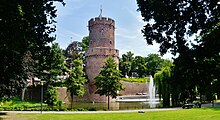
- St. Stevenskerk ( Gothic ), built in the 13th century, restored after the Second World War
- town hall
- The city scales on the Great Market (now Cafe-Restaurant)
- The Valkhof with the Barbarossa ruins (formerly Roman and Carolingian buildings at this point) and the St. Nicholas Chapel
- Remains of the ramparts: the Belvedère and the Kronenburgerturm (Kruittoren) in the Kronenburgerpark
- Titus Brandsma Memorial Church
- National Bicycle Museum Velorama
- The Nijmegen Waal Bridge, built between 1931 and 1936
- Museum Het Valkhof , modern museum with Roman and other archaeological finds as well as ancient and modern art (Kelfkensbos 59, on the eastern edge of the city center), remarkable architecture by UNStudio ( Ben van Berkel and Caroline Bos )
- muZIEum , experience museum about seeing and not seeing, including “Dialogue in het donker”, where visitors can experience what it is like not to see
- FiftyTwoDegrees
- Auto Palace petrol station
- The Concertgebouw de Vereeniging concert hall
- The city theater Stadsschouwburg Nijmegen
education and Science

The campus of Radboud University Nijmegen and some locations of the Hogeschool van Arnhem en Nijmegen (HAN) are located near the Nijmegen Heyendaal train station . In total, almost 33,000 people study in Nijmegen. The Max Planck Institute for Psycholinguistics has been located in Nijmegen since 1980 and also cooperates closely with the university.
Furthermore, the main building of the ROC Nijmegen, a center for vocational training, is located right next to the main train station .
Entertainment and sport
- There is a Holland Casino in Nijmegen .
- The professional football club NEC Nijmegen is at home in the Goffert Stadium (southwest of the city center, around 12,500 seats) .
- The Sonisphere Festival started in Goffert Park in 2009 . In the same year there was the first FortaRock Festival here .
- A well-known club for live music and parties is Doornroosje .
- The Nijmegen Devils play in the Triavium ice stadium .
- Since 1909 the Nijmegen March (de Nijmeegse Vierdaagse) has taken place every year in July (with a few interruptions) , an international four-day hike over 200 km, covering distances of 30 to 50 km per day. With over 40,000 participants, the event is the largest of its kind in the world.
- The Seven Hill Run with start and finish in Nijmegen is one of the largest fun runs in Europe with between 20,000 and 30,000 runners annually.
Personalities
- Theophanu (approx. 955 / 960–991), wife of Emperor Otto II, co-empress of the Roman-German Empire
- Henry VI. (1165–1197), Holy Roman Emperor
- Marsilius von Inghen (1335 / 40–1396), university teacher in Paris and Heidelberg
- Jakob Berneri (14th / 15th century), priest, official, university professor in Cologne
- the Limburg brothers (approx. 1375 to approx. 1416), miniature painters a. a. of the Book of Hours Très Riches Heures du Duc de Berry
- Antonius Broickwy (1470–1541), Franciscan and theologian
- Gerhard Geldenhauer (1482–1542), Lutheran theologian and reformer
- Petrus Canisius (1521–1597), theologian, Catholic saint
- Johan Gregor van der Schardt (around 1530 – after 1581), mannerist sculptor
- Gerrit Hazenpoet (burned at the stake in Nijmegen in 1557), martyr of the Anabaptist movement
- Albertus Arnoldus van Hutten (1587 / 88–1663), preacher and scholar
- Johannes Smetius (1590–1651), pioneer of provincial Roman archeology and preacher of the Stevenskerk
- Otto Marseus van Schrieck (1619 / 20–1678), still life painter
- Francois Nicolaas Fagel (1645–1718), a field marshal lieutenant in the Habsburg Netherlands
- Gerhard Noodt (1647–1725), lawyer
- Antonius Schultingh (1659–1734), lawyer
- Cornelis Rudolphus Theodorus Krayenhoff (1758–1840), doctor, general, cartographer and minister
- Theodorus Frederik van Capellen (1762–1824), naval officer
- Jan Willem Janssens (1762–1838), nobleman, soldier and statesman, Governor General of the Dutch East Indies
- Henriette Presburg (1788–1863), mother of Karl Marx
- Richard van Rees (1797–1875), mathematician and physicist
- Henri Leeuw sr. (1819–1909), sculptor
- Gerard Marius Kam (1836–1922), entrepreneur , local politician , local researcher and collector, as well as founder of the former Rijksmuseum Museum Kam named after him
- Æneas Mackay the Younger (1839–1909), politician
- Willem Leonard Pieter Arnold Molengraaff (1858–1931), legal scholar
- Henri Leeuw Jr. (1861–1918), painter and sculptor
- Oscar Leeuw (1866–1944), architect
- Anthony Johannes Blok (1868–1934), criminal lawyer
- Titus Brandsma (1881–1942), Carmelite, priest, philosophy professor and martyr (beatification 1985)
- Alfred Nourney (1892–1972), survivor of the Titanic disaster
- Robert Noorduyn (1893–1959), aircraft manufacturer
- Annie Romein-Verschoor (1895–1978), Dutch author and journalist
- Joris Ivens (1898–1989), documentary filmmaker
- Marinus van der Goes van Naters (1900–2005), politician
- Jan Volkert Rijpperda Wierdsma (1904–1981), legal scholar
- Alfred Mazure (1914–1974), author and cartoonist
- Clemens CJ Roothaan (1918–2019), physicist, chemist and computer architect
- Edy de Wilde (1919–2005), museum director, exhibition organizer and art collector
- Jan Hubertus (1920–1995), painter
- Johannes Bluyssen (1926–2013), Bishop of 's-Hertogenbosch
- Johan Peter Gumbert (1936–2016), historian
- Jan Kees Haalebos (1942–2001), Provincial Roman Archaeologist
- Marcel Chappin (* 1943), Catholic theologian
- Guido de Werd (* 1948), art historian, museum director
- Jos Hermens (* 1950), long-distance runner
- Eddie Van Halen (* 1955), rock musician
- Frank Boeijen (* 1957), pop musician
- Bo van de Graaf (* 1957), jazz musician
- Anne-Marie Quist (* 1957), rower
- Marcel Boekhoorn (* 1959), billionaire
- René Creemers (* 1959), jazz musician
- Ben Liebrand (* 1960), DJ
- Frank Dekkers (* 1961), artist
- Martina den Hertog-Vogt (* 1961), German translator
- Michiel Braam (* 1964), jazz musician
- Ben Tijnagel (1964–2005), ice hockey player
- Theo Bos (1965-2013), football player
- John Feskens (* 1965), football player and coach
- Friso Nijboer (* 1965), chess player
- Selena (born 1965), singer
- Maya Hakvoort (* 1966), musical star
- Toine Heijmans (* 1969), writer and journalist
- Kamiel Maase (* 1971), long-distance runner
- Robert-Jan Derksen (* 1974), professional golfer
- Dennis Gentenaar (* 1975), soccer goalkeeper
- Bas van Abel (* 1977), designer, electrical engineer and entrepreneur
- Sabine Pfeifer (* 1980), singer, actress and presenter
- Flin van Hemmen (* ≈1985), jazz musician
- Willem Janssen (* 1986), football player
- Susan Krumins (* 1986), middle and long distance runner
- Piet Velthuizen (* 1986), football goalkeeper
- Niña Weijers (* 1987), writer
- Youri Loen (* 1991), soccer player
- Sieneke Peeters (* 1992), singer
- Amira Willighagen (* 2004), singer
Town twinning
Sister cities of Nijmegen are:
-
 Pskov , Russia
Pskov , Russia
-
 Masaya , Nicaragua
Masaya , Nicaragua
-
 Higashimatsuyama , Japan
Higashimatsuyama , Japan
-
 Gaziantep , Turkey
Gaziantep , Turkey
-
 Albany , USA
Albany , USA
-
 Oulu , Finland
Oulu , Finland
literature
- Jos Seveke: Nijmegen. Pictures from the life of the imperial city of the Netherlands . Put on display and discussed: Jos Seveke. Photographs v. Louis Drent; "Photo Gelderland". [Translated into German v. Hans Grimmelt]. - Nijmegen; Utrecht: Dekker & van de Vegt, 1955, 102 pp.
- Friedrich Gorissen : Nijmegen , Lower Rhine City Atlas; Row 2. Geldrische Cities; H.1, Boss, Kleve 1956
- Jan Kuys: Nijmegen , in: Reallexikon der Germanischen Altertumskunde , Volume 21, Naualia - Østfold . 2nd edition, de Gruyter, Berlin / New York, NY 2002, pp. 217 f., ISBN 3-11-017272-0 .
- Uwe Ludwig, Thomas Schilp (ed.): Middle Ages on the Rhine and Maas , Waxmann, Münster 2004, ISBN 978-3-8309-1380-1
- Pieter Leupen: Nijmegen . In: Lexicon of the Middle Ages (LexMA). Volume 6, Artemis & Winkler, Munich / Zurich 1993, ISBN 3-7608-8906-9 , Sp. 1149-1151.
Web links
- Website of the municipality (Dutch)
- Tourist website of Nijmegen (Dutch, German, English)
- Hylke Roodenburg: Urban history (German)
- Valkhof Museum website (Dutch, German, English)
- Research project TU Berlin: Nijmegen, Valkhofkapelle (German)
- Virtual tour of Nijmegen (Dutch, German, English, French)
- Roman Nijmegen In: livius.org (English)
Individual evidence
- ↑ Bevolkingsontwikkeling; regio per maand . In: StatLine . Centraal Bureau voor de Statistiek (Dutch)
- ↑ Langenscheidt's Pocket Dictionary Dutch, ISBN 3-468-11232-7 , p. 287
- ↑ Jan Buylinckx et al.: Ach lieve tijd. Twintig eeuwen Nijmegen, de Nijmegenaren en hun rijke verleden. Waanders, Zwolle 1985, p. 6 .
- ↑ Kerncijfers wijken en buurten 2018 Centraal Bureau voor de Statistiek , accessed on October 26, 2018 (Dutch)
- ↑ a b Reallexikon Vol. 21 p. 217
- ↑ Pieter Leupen: Nijmegen . In: Lexicon of the Middle Ages (LexMA). Volume 6, Artemis & Winkler, Munich / Zurich 1993, ISBN 3-7608-8906-9 , Sp. 1149-1151 (here Sp. 1149).
- ^ Roodenburg: Urban development history .
- ↑ Ludwig / Schilp: Middle Ages on the Rhine and Maas , Münster 2004, pp. 88 and 93.
- ^ Research project TU Berlin
- ↑ a b c Pieter Leupen: Nijmegen . In: Lexicon of the Middle Ages (LexMA). Volume 6, Artemis & Winkler, Munich / Zurich 1993, ISBN 3-7608-8906-9 , Sp. 1149-1151 (here Sp. 1150).
- ^ History page Noviomagus.nl of Nijmegen .
- ^ William I. Hitchcock : The Bitter Road to Freedom: A New History of the Liberation of Europe, p. 101.
- ↑ Michiel Kokke: Bombardment geen forgeting, wel een 'faux pas'. de Gelderlander, March 28, 2013, accessed February 22, 2020 (Dutch).
- ↑ Joost Rosendaal: Nijmegen 44: Verwoesting, verdriet en verwerking . Uitgeverij Vantilt, 2009, ISBN 978-94-6004-011-5 (Dutch).
- ↑ Seen and photographed in September 2019 during a city tour.
- ↑ a b cycling in Nijmegen , July 15, 2017; accessed on March 15, 2020.
- ↑ Nijmegen celebrations! In: BICYCLE DUTCH. May 23, 2016, accessed July 27, 2016 .
- ↑ Velo-city 2017 - Arnhem-Nijmegen, Netherlands. In: www.velo-city2017.com. Retrieved October 10, 2016 .
- ↑ Route | Via Romana. Retrieved on March 5, 2018 (German).
- ^ Yearbook of the Shipbuilding Society: Volume twenty-ninth with a listing of several shipyards and naming of shipbuilding engineers in Nijmegen. Springer Verlag, 2013, ISBN 978-3-642-90166-9 ; accessed on March 15, 2020.
- ↑ Coalitieakkoord 'Nijmegen: Samen vooruit' Gemeente Nijmegen, accessed on July 16, 2018 (Dutch)
- ↑ a b Results of the local elections: 1982–2002 2006 2010 2014 2018 , accessed on December 30, 2018 (Dutch)
- ↑ Gemeenteraad In: Huis van de Nijmeegse Geschiedenis , accessed on July 16, 2018 (Dutch)
- ^ College van burgemeester en wethouders Gemeente Nijmegen, accessed on July 16, 2018 (Dutch)
- ↑ Brul officieel burgemeester van Nijmegen. In: Trouw . De Persgroep Nederland , March 30, 2012, accessed July 16, 2018 (Dutch).
- ↑ Archived copy ( Memento of the original from March 12, 2011 in the Internet Archive ) Info: The archive link was inserted automatically and has not yet been checked. Please check the original and archive link according to the instructions and then remove this notice.
- ↑ Partnership with Pskow ( Memento of the original from May 1, 2009 in the Internet Archive ) Info: The archive link was inserted automatically and has not yet been checked. Please check the original and archive link according to the instructions and then remove this notice.
- ↑ Partnership with Masaya ( Memento of the original from May 1, 2009 in the Internet Archive ) Info: The archive link was inserted automatically and has not yet been checked. Please check the original and archive link according to the instructions and then remove this notice.
- ↑ Partnership with Gaziantep ( Memento of the original from May 1, 2009 in the Internet Archive ) Info: The archive link was inserted automatically and has not yet been checked. Please check the original and archive link according to the instructions and then remove this notice.


